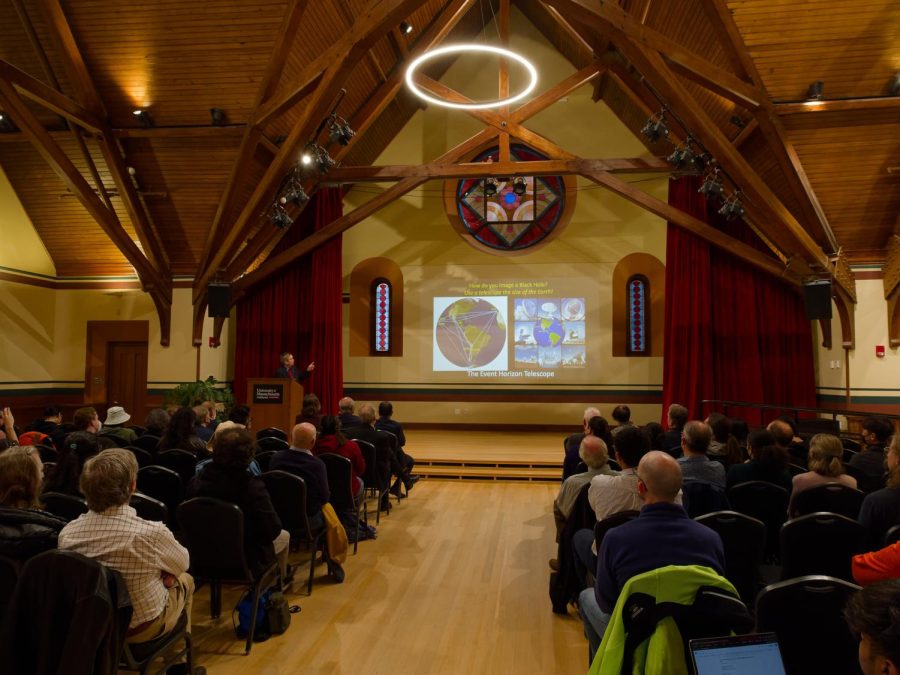Work done by astrophysics faculty Grant Wilson and Min Yun has led to an intriguing discovery: a massive galaxy protocluster caught in its development only a billion years after the Big Bang.
Wilson and Yun helped develop technology that led to this discovery as part of an international team of astronomers led by Peter Capak of the California Institute of Technology. The group’s findings were published on January 12 in the scientific journal Nature.
“I think it’s pretty safe to say [the discovery] took us all by surprise,” Wilson said. “[Finding the cluster] in the act of formation so soon after the Big Bang was not what we were expecting.”
According to Wilson, protoclusters, while “not at odds with current simulation theory,” are thought to be extremely rare. It was a shock to the researchers that one was found so quickly.

(LMT). Wilson said he came to the University of Massachusetts with the goal of developing the camera, which was designed for use in the LMT. UMass is helping to build the LMT on a mountain in Mexico.
According to Yun, who came to UMass in 2000, the LMT, is specifically “designed to study the formation and evolution of young massive galaxies soon after the Big Bang.” A problem arose, however, when work on the AzTEC camera was completed before the LMT.
“For a short while,” said Wilson, “We had a world-class camera without a home.”
The researchers were invited to install AzTEC on the James Clerk Maxwell Telescope in Hawaii. They only stayed for a few months, during which AzTEC allowed them to “image the sky in an entirely new way and find hundreds of new galaxies never before seen by other telescopes.”
One of these new galaxies was AzTEC-3. Nothing distinguished it, besides being the third brightest galaxy found in a section of sky called the COSMOS Field. “When we found AzTEC-3, we had no idea it would turn out to be in such a special part of the universe,” said Wilson.
Galaxies like AzTEC-3 are difficult to study because they are extremely far away and faint. The world’s largest telescopes are required for useful analysis. There are also many other galaxies between Earth and the AzTEC-3 galaxy complicating the identification process.
“The discovery reported in this article is really a case of a good calculated gamble and a clever experimental design that paid off because we did not know for sure there would be a protocluster here,” said Wilson. “Our Caltech friends did the hardest work of this project,” as they had to go “galaxy by galaxy and picked out the ones that are associated with the protocluster.”
COSMOS-AzTEC, besides being an unexpected find, has several other intriguing features. AzTEC-3, the protocluster’s central starburst galaxy, is extremely massive and produces nearly 1,000 new stars each year. The protocluster also houses a massive black hole and luminous quasar nearby.
This surprised the researchers. Yun expected to find “baby galaxies” and instead found “a quasar, which is generally considered an object with some history under its belt already.”
Wilson said he hoped the discovery would provide astronomers with a good “laboratory” for studying both black holes and quasars.
“Astronomers still don’t have a good handle on when, or even how,” very massive galaxies and very massive black holes form, Wilson said. “This is just scratching the surface of some very fundamental questions about galaxies.”
Wilson and Yun both seem excited to continue studying these high red-shift galaxies at the LMT, which is now nearly complete. AzTEC and other advanced instruments will be installed later this year. Once this happens, research into galaxies like AzTEC-3 are expected by Yun and Wilson to progress far more rapidly, as the LMT will make AzTEC and other new instruments 10 times more powerful.
“[With the] AzTEC/LMT combination, we will discover galaxies like AzTEC-3 at a rate of about one a minute. This is going to fundamentally change our access to star-bursting galaxies throughout the universe,” said Wilson.
This will perhaps help to resolve some of the questions raised by the discovery.
“The real question here is, why were we able to find one so quickly? Is it because we were extremely lucky? Or is it because they are not so rare after all?” said Wilson.
Yun appeared confident the LMT will lead to new discoveries. “I predict that we will be answering a lot more questions from you within the next year,” he said.
The AzTEC camera was partially funded by the National Science Foundation.
“With support from NSF, this program is providing the largest survey of the nature and evolution of submillimeter galaxies to date,” said Dr. Richard Barvainis, a program manager in NSF’s Division of Astronomical Sciences.
“The result will be an unprecedented catalog of well over 1,000 new submillimeter galaxies,” Barvainis said. “The project will also help define the properties of high redshift clusters of galaxies, such as the one recently described in a Nature publication.”
Melanie Muller can be reached at [email protected].






